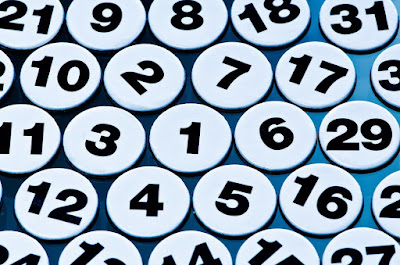Did you know that in the lotto six numbers game, we guarantee the combination of 123456 to lose?
Mathematicians who don’t know the lotto game like to claim that every set of lotto six numbers has the same chance of winning as any other. But this is simply not the case.
After carefully analyzing the results of the draws of over 200 different lottery games around the world - dating back to 1955 - I verified the following incredibly simple rule based on the logical calculation of probabilities:
What is MOST POSSIBLE happens MOST OFTEN.
What is LEAST POSSIBLE happens LESS OFTEN.
So the basis of my lottery strategies is to play the odds - to play what is most likely to happen. If you play a combination that happens only five percent of the time, you can expect that combination to lose 95 percent of the time. If something happens rarely or never in lottery draws, or if something has never happened before in the history of a lottery game, shouldn’t common sense tell even a math teacher not to expect it to happen for the very first time just because he or she bet on it? Why put obstacles in the way of winning?
Here are 10 reasons you should never spend a dollar on the toxic lotto six number combination of 123456. Read on and see why this lotto six numbers, 123456, should never be marked as a set on your betting slip.
1) Consecutive numbers: My common sense formula tells you to never play lotto six numbers on a game board. We have not drawn six consecutive numbers in any national or international lotto game. Even five consecutive numbers is a very rare event that, in most pick-6 lotto games, has never happened once.
2) A GROUP OF NUMBERS. You should also not play all lotto six numbers in a group of numbers, e.g. all one-digit numbers, all ten-digit numbers, all twenty-digit numbers, etc. It is highly unlikely that they will draw all six winning numbers from a single group of numbers, as this has never happened before in any lotto game, in America, or elsewhere.
3) REPEAT BETS. Avoid pattern bets. The thousands play patterns of numbers marked in a line to form a straight line - either across the betting slip or vertically or diagonally on every draw. If these numbers were to win, the payout would be tiny.
4) NEIGHBORING NUMBERS. Neighboring numbers are numbers on either side of a lotto number. For example, the neighboring numbers of 28 are 27 and 29. Less than 7% of pick-6 lotto draws have even four neighboring numbers.
5) EVERYTHING IS DOWN, NOT HALF. They usually spread out the winning numbers over the entire number field. If you take a field of numbers and cut it in half, you get the low half or the high half. In a 49-number game, numbers 1 through 24 are in the low half and numbers 25 through 49 are in the high half. Full high or full low numbers are rarely drawn, occurring only two percent of the time.
6) CALENDAR NUMBERS. The natural tendency of novice lotto players is to bet on the lowest numbers, especially the calendar numbers from 1 to 31, because of the importance placed on birth dates, anniversaries, and children’s ages. This means that the most played numbers are those from 1 to 31. Most pick-6 lotto games have over 40 or 50 numbers. If the calendar numbers are winning, the top prize pool is diminished if we divide it among dozens of other winners. (Note that the payouts are always small when four or more numbers are in the low end of the range. The payouts are always higher when the highest numbers come up, because fewer winners share the prize pool. Also note that in draws where there is no jackpot winner, the winning numbers are usually higher than normal.)
7) END OF THE BELL CURVE. They drew lottery numbers at random. If you want to play the lotto to win, it is important to select your lotto numbers and place them on your betting slips in patterns that most closely resemble how the numbers are actually drawn. When you add up the six winning numbers in your state’s lotto game, you get a sum. Add up the six winning numbers from several draws, and you’ll find that most winning combinations fall within the same range of sums.
A typical 6/49 Lotto draw might yield a sum of 150: 3 + 17 + 23 + 24 + 36 + 47 = 150
In a 6/49 lotto game, the sums range from a minimum of 21 to a maximum of 279.
In a field of 49 numbers, there only one combines six numbers whose sum is equal to 21:
1 + 2 + 3 + 4 + 5 + 6 = 21
And, in the 6/49 lotto game, only one six-number combination results in 279:
44 + 45 + 46 + 47 + 48 + 49 = 279
These two combinations have the smallest and largest possible sum. And they occur only once, at the ends of a bell curve, making it virtually impossible to draw a winning combination for either group of numbers.
In the 49-number pick-6 lotto game, the most frequent sum is 150, which is the median sum.
The sums of the lotto combinations can be compared to the sums of the combinations on a pair of dice. At both ends of a bell curve, there is only one way to make a 12 (boxcars, 6 and 6), and there is only one way to make a 2 (snake eyes, 1 and 1). But there are six ways to make a 7 - the top center point of a bell curve for a pair of dice. These combinations are 6 and 1, 1 and 6, 5 and 2, 2 and 5, 4 and 3, 3 and 4. So, of course, it is much easier to roll a 7 on the dice than any other number because there are more ways to get the sum of 7.
8) NOT A BALANCED GAME. A balanced game is a set of six numbers that falls within the range of most likely sums.
9) DOES NOT REACH 70% OF THE RANGE OF MOST LIKELY SUMS. In a 6/49 lotto game, 27.4% of the sums fall within the range of 115-185 but account for 71.32% of the jackpot winning combinations! This means that if you play a six-number combination with an amount that is above or below the 115-185 range, you can expect that the numbers with the amount you selected will not appear, giving you no chance of winning, 71% of the time.
If you want to give your chances more weight, i.e. play with odds more in your favor, use my “70% rule” and make sure your lotto bet amounts are within the most likely range for the lotto game you are playing. The range of amounts varies depending on the number field of the lotto game. For example, my 70% Most Likely® range for the popular Fantasy 5 5/39 game is 75 to 125.
Warning! The Auto Lotto Processor aims to give you a higher chance of winning the lottery when you use the tricks and tips found in it.
Click https://deliverit.blogspot.com/p/auto-lotto-processor.html for more details.
10) 20,000 TICKETS SOLD IN EACH DRAW. If reasons 1-9 didn’t convince you to avoid the guaranteed losing combination, which is 01-02-03-04-05-06, reason number 10 should. A ten million dollar cash jackpot would only pay out $500 to each of the 20,000 first prize winners.





